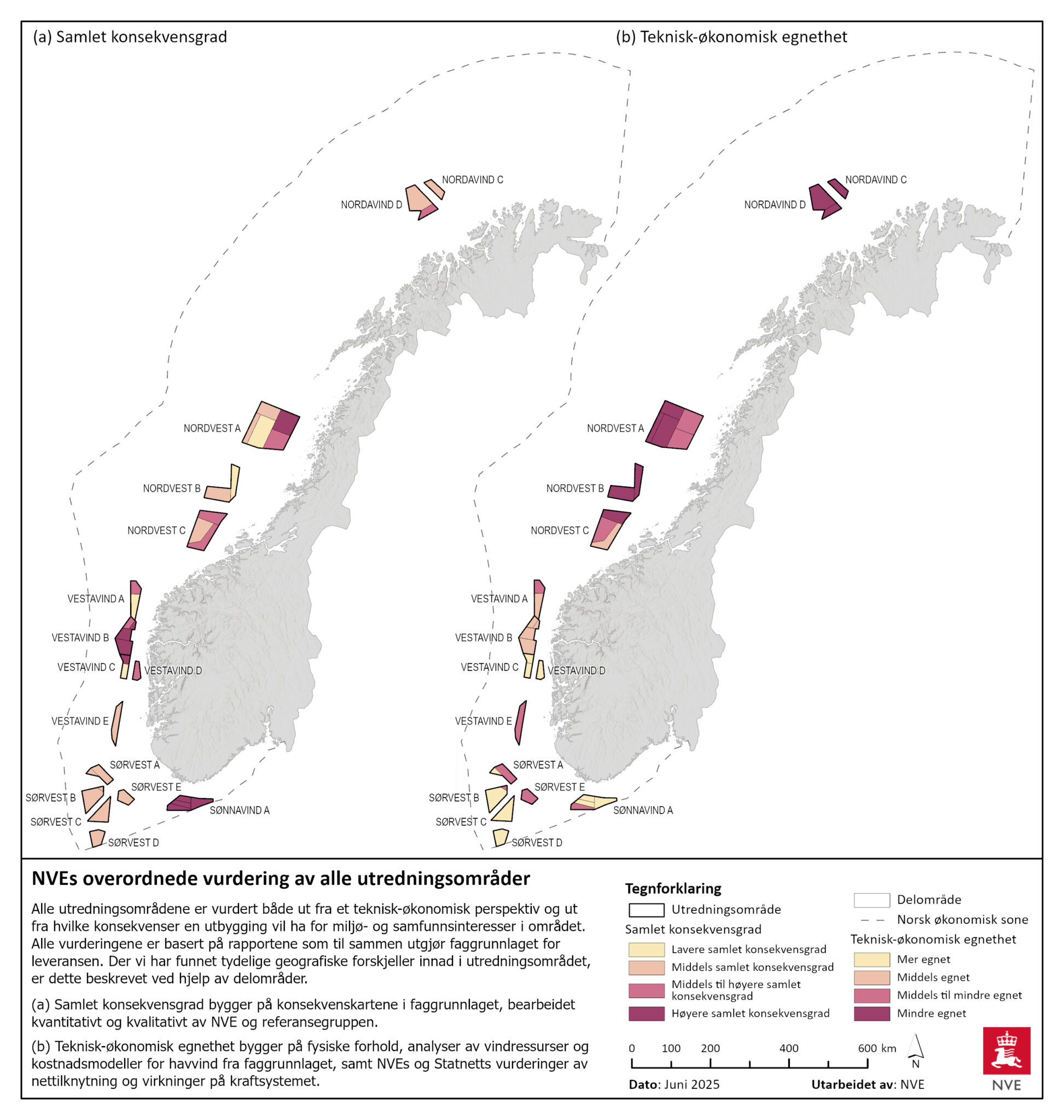Strategic impact assessment for new offshore wind areas published – good opportunities in several locations
NVE has been tasked by the Ministry of Energy to carry out a strategic impact assessment of 18 areas for offshore wind power, which was submitted to the Ministry on June 23, 2025. The Ministry of Energy has now sent the impact assessment on a public consultation, with a deadline for input on October 1, 2025. There are four areas in particular that stand out as well-suited among the 18, these are Vestavind C, Sørvest B, Sørvest C and Sørvest D.
The impact assessment can be found here. There are four areas in particular that stand out as well-suited among the 18, these are Vestavind C, Sørvest B, Sørvest C and Sørvest D.
- Vestavind C: is located in the Norwegian Sea off the western coast of Norway. The area is considered more technically and economically suitable for floating offshore wind compared to other assessed areas, which means that the expected energy costs are lower than for most other assessed areas. The area has good wind resources compared to the other areas suitable for floating offshore wind. It is relatively close to land, which makes grid connection relatively easy in a region where the power system will benefit from offshore wind production. At the same time, there are internal variations in the area, and particularly in the northern part conflicts of interest may rise due to established petroleum activities (the Troll field).
- Sørvest B: is located in the North Sea and has good wind resources compared to the other assessed areas. The area is far from land, but NVE considers this to be manageable through the use of a converter station. Offshore wind activity is considered to have medium consequences for biodiversity, especially the impact on migratory birds, cod fish and sandeel. In addition, the area overlaps with important spawning areas for several fish species.
- Sørvest C: is also located in the North Sea, and has better wind resources than most other areas, including compared to the other areas suitable for fixed offshore wind. The area is far from land, but NVE considers this to be manageable through the use of a converter station. Sørvest C also has medium consequences for biodiversity, similar to Sørvest B, especially related to possible impact on migratory birds, cod fishing and sandeel, as well as important spawning areas for several fish species.
- Sørvest D: is also located in the North Sea, and the wind resources in the area are stronger compared to the other assessed areas. The area is far from land, but NVE considers this to be manageable through the use of a converter station. Sørvest D has relatively short distances to other countries around the North Sea, which means that the area may be suitable for a possible hybrid connection. This Sørvest area is also considered to have a medium impact on biodiversity for the same reasons as mentioned for B and C above, but among the Sørvest areas, Sørvest D is considered to have the lowest impact on spawning fish.
In addition to these areas, Vestavind D and Sønnavind A are also areas that are technically and economically well suited, but with higher overall consequences on other societal aspects. Some areas are also considered to be less technically and economically suitable for offshore wind, such as Nordavind C, Nordavind D and Nordvest B.
NVE has summarized the findings of the impact assessment in overall assessments of techno-economic suitability and overall societal consequences per area. The techno-economic assessment emphasizes, among other things, wind conditions, depth and distance to land and connection to the grid. The consequences for the power system are also included in this assessment. In the assessment of overall consequences, NVE has qualified and quantified the 22 study topics for the impact assessment, which include biodiversity, the relationship to other use of the areas such as fisheries, shipping, petroleum activities and offshore aquaculture, the relationship to cultural monuments and the cultural environment, infrastructure such as aviation, radar and defense interests, and pollution. Within the areas, there is great variation in terms of technical and economic suitability and/or consequences for the environment and other public interests. NVE has therefore also indicated suitability on the basis of sub-areas. The illustration below shows the overall assessment of the areas for overall consequences and for techno-economic suitability.

Illustration: NVE
NVE emphasizes that offshore wind technologies generally have higher energy costs, and they are not profitable without support schemes at present. It is therefore important to bear in mind that even if areas are assessed as technically and economically suitable, this is in comparison with other areas, and not with energy production as such. The energy costs will therefore still be much higher than the costs associated with onshore wind power, for example.
Furthermore, NVE emphasizes that the impact assessment looks at each area separately. Consequently, the overall consequences are only assessed for each individual area; if several of the areas, especially those located close to each other, are considered to be opened, the overall consequences of this must be assessed separately.
NVE is also of the opinion that there is a need for more knowledge gathering, particularly in relation to the consequences of offshore wind power for biodiversity. Work is therefore underway on a plan for gathering knowledge, which the Directorate has announced will be published as soon as it is ready.
Finally, it should also be mentioned that NVE, in consultation with the Ministry of Energy, concluded during the work on the impact assessment that the areas Nordavind A and Nordavind B should not be considered further. This was because of the Norwegian Armed Forces’ interests in the High North and the fact that offshore wind farms in these areas were considered to have consequences for national security.


